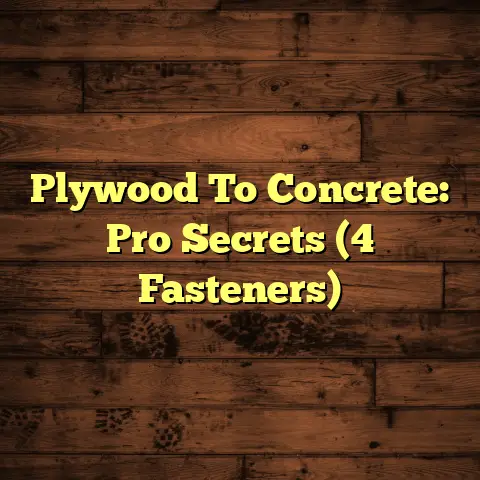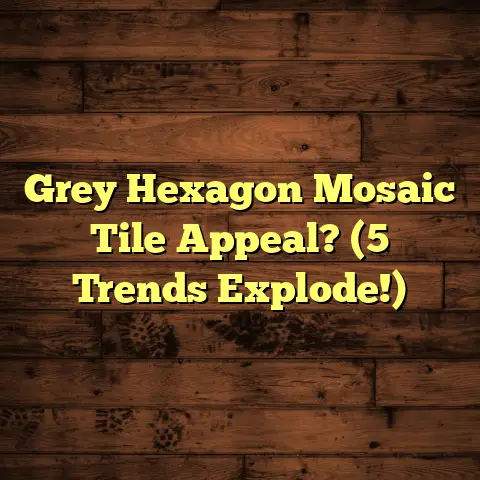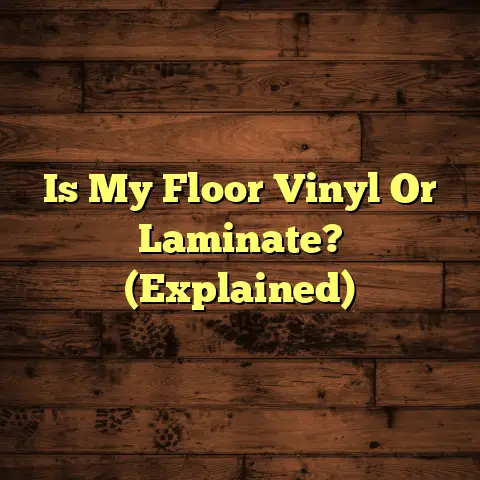Types of Wood Flooring? (5 Best for Value!)
Imagine your home is a painting.
Think about it.
The walls are the canvas, the furniture the subject, and the lighting the mood.
But what about the floor?
Ah, the floor!
It’s the foundation upon which everything else rests.
Just like a painter needs a solid base, a homeowner needs reliable, beautiful flooring.
And that’s where wood flooring comes in – a timeless choice that can truly transform a space.
Let’s dive in, shall we?
The Beauty of Wood Flooring
There’s just something about wood flooring, isn’t there?
It’s got that timeless elegance, that touch of class that can elevate any room.
Whether you’re going for a rustic farmhouse vibe, a sleek modern look, or something in between, wood flooring just works.
It complements almost any interior style.
But it’s more than just aesthetics.
Wood flooring has a history, a story to tell.
Think about it: people have been using wood for flooring for centuries!
From the grand castles of Europe to the cozy cottages of the countryside, wood has always been a go-to choice.
It’s evolved, of course, from rough-hewn planks to precisely milled boards, but the essence remains the same.
And let’s not forget the emotional connection people have with wood.
It evokes feelings of warmth, comfort, and a sense of home.
That satisfying thud as you walk across a solid hardwood floor?
That’s not just sound, my friend; it’s a feeling!
Understanding Different Types of Wood Flooring
Now, before we get into the nitty-gritty, let’s take a look at the main categories of wood flooring.
We’re talking about:
- Solid Hardwood
- Engineered Hardwood
- Bamboo
- Laminate
- Cork
Each has its own unique characteristics, advantages, and disadvantages.
Solid Hardwood: This is the real deal – planks made from a single piece of wood. It’s durable, beautiful, and can last for generations.
Engineered Hardwood: Made from layers of wood with a hardwood veneer on top. This is more stable than solid wood and less prone to warping.
Bamboo: A sustainable and stylish option.
Bamboo flooring is durable and adds a unique look to your home.
Laminate: A synthetic material designed to mimic the look of wood. It’s budget-friendly and easy to install.
Cork: A soft, comfortable, and eco-friendly option.
It’s great for sound insulation and is comfortable underfoot.
We’ll delve deeper into each of these in a bit.
But for now, just know that there’s a wood flooring option out there for every budget, style, and lifestyle.
The 5 Best Types of Wood Flooring for Value
Alright, let’s get to the good stuff!
Based on my experience as a flooring contractor, here are my top 5 picks for wood flooring that offers the best bang for your buck:
1. Solid Hardwood
Ah, solid hardwood.
The king of the castle, the crème de la crème.
This is the stuff that dreams are made of.
Composition and Construction:
Solid hardwood is exactly what it sounds like: planks milled from a single piece of wood.
Common wood types include:
- Oak (red and white)
- Maple
- Walnut
- Hickory
- Cherry
Each species has its own unique grain pattern, color variation, and hardness.
Oak is a classic choice, known for its durability and versatility.
Maple is lighter in color and has a more subtle grain.
Walnut is rich and dark, adding a touch of luxury.
Longevity and Resale Value:
One of the biggest advantages of solid hardwood is its longevity.
With proper care, it can last for decades, even centuries.
I’ve seen homes with original hardwood floors that are still in great shape after 100+ years!
And because it’s such a desirable feature, solid hardwood can significantly increase your home’s resale value.
According to the National Association of Realtors, hardwood floors are one of the top features that buyers look for in a home.
Potential for Refinishing:
Another huge plus is the potential for refinishing.
Over time, hardwood floors can get scratched, dented, and worn.
But with solid hardwood, you can sand down the surface and apply a fresh coat of stain and finish, making it look brand new again.
You can typically refinish a solid hardwood floor multiple times over its lifespan.
Things to Consider:
-
Price: Solid hardwood is generally more expensive than other types of wood flooring.
-
Installation: It requires professional installation, which adds to the cost.
-
Moisture Sensitivity: Solid hardwood is susceptible to moisture damage, so it’s not ideal for basements or bathrooms.
2. Engineered Hardwood
Think of engineered hardwood as solid hardwood’s smarter, more adaptable cousin.
It offers the beauty of real wood with added stability and versatility.
How it’s Made:
Engineered hardwood is constructed from multiple layers of wood veneer glued together.
The top layer is a solid hardwood veneer, giving you the look and feel of real wood.
The core layers are typically made from plywood or high-density fiberboard (HDF).
This multi-layered construction makes engineered hardwood more stable than solid hardwood, meaning it’s less likely to warp, expand, or contract with changes in humidity.
Advantages Over Solid Hardwood:
-
Stability: As mentioned, engineered hardwood is more stable than solid hardwood, making it suitable for a wider range of environments.
-
Moisture Resistance: While not waterproof, engineered hardwood is more resistant to moisture than solid hardwood.
-
Installation: It can be installed using a variety of methods, including glue-down, nail-down, and floating.
-
Cost: Engineered hardwood is generally less expensive than solid hardwood.
Versatility in Different Environments:
Because of its stability and moisture resistance, engineered hardwood can be installed in areas where solid hardwood is not recommended, such as:
- Basements
- Kitchens
- Bathrooms (with proper precautions)
I’ve installed engineered hardwood in countless basements, and it’s held up beautifully.
Things to Consider:
-
Refinishing: While you can refinish engineered hardwood, you can only do it once or twice, depending on the thickness of the veneer.
-
Veneer Thickness: The thicker the veneer, the more durable the flooring.
3. Bamboo Flooring
Looking for a sustainable and stylish alternative to traditional hardwoods?
Look no further than bamboo flooring.
Bamboo as a Sustainable Alternative:
Bamboo is a rapidly renewable resource that grows much faster than hardwood trees.
It can be harvested in as little as 3-5 years, compared to decades for hardwoods.
This makes it a more environmentally friendly choice.
Durability and Unique Aesthetic:
Bamboo flooring is surprisingly durable.
In fact, some types of bamboo flooring are even harder than oak!
It has a unique aesthetic, with a distinctive grain pattern that adds character to any room.
You can find bamboo flooring in a variety of colors and styles, from light and natural to dark and exotic.
Eco-Friendly Properties:
In addition to being sustainable, bamboo flooring is also naturally resistant to pests and mold.
It’s a great choice for people with allergies or sensitivities.
Things to Consider:
-
Quality Variations: The quality of bamboo flooring can vary widely, so it’s important to choose a reputable brand.
-
Moisture Sensitivity: Like hardwood, bamboo is susceptible to moisture damage.
-
Formaldehyde Emissions: Some bamboo flooring contains formaldehyde, a known carcinogen.
Look for bamboo flooring that is certified by the Forest Stewardship Council (FSC) or the Greenguard Environmental Institute.
4. Laminate Flooring
If you’re on a tight budget, laminate flooring is a great option to consider.
It offers the look of real wood at a fraction of the cost.
Construction of Laminate Flooring:
Laminate flooring is made from multiple layers of synthetic materials.
The top layer is a photographic image of wood (or stone, tile, etc.) covered with a clear, durable wear layer.
The core layer is typically made from high-density fiberboard (HDF) or medium-density fiberboard (MDF).
The bottom layer is a backing that provides stability and moisture resistance.
Appeal for Budget-Conscious Consumers:
Laminate flooring is significantly cheaper than hardwood, engineered hardwood, or bamboo.
It’s also easy to install, making it a popular choice for DIYers.
Ability to Mimic the Appearance of Real Wood:
Thanks to advances in printing technology, laminate flooring can now mimic the appearance of real wood with amazing accuracy.
You can find laminate flooring that looks like oak, maple, walnut, hickory, and just about any other wood species.
Scratch and Moisture Resistance:
Laminate flooring is more resistant to scratches and moisture than real wood.
This makes it a good choice for homes with pets or children.
Things to Consider:
-
Not Real Wood: Laminate flooring doesn’t have the same warmth and character as real wood.
-
Refinishing: You can’t refinish laminate flooring.
If it gets damaged, you’ll need to replace it.
-
Sound: Laminate flooring can be noisy to walk on.
Adding an underlayment can help reduce the noise.
5. Cork Flooring
Cork flooring is a unique and eco-friendly option that offers a number of benefits.
Unique Characteristics:
Cork is a natural material harvested from the bark of cork oak trees.
It’s soft, resilient, and has a distinctive texture.
Softness and Insulation Properties:
Cork flooring is incredibly comfortable to walk on.
It has a natural give that cushions your feet and joints.
It also provides excellent insulation, helping to keep your home warm in the winter and cool in the summer.
Sustainability:
Cork is a sustainable material because the bark of the cork oak tree regenerates after harvesting.
The trees are not harmed in the process.
Benefits for Sound Absorption and Comfort Underfoot:
Cork flooring is a great choice for sound absorption.
It can help reduce noise levels in your home, making it a good option for apartments or homes with multiple stories.
Things to Consider:
-
Durability: Cork flooring is not as durable as hardwood or laminate.
It can be dented or scratched by heavy furniture or sharp objects.
-
Moisture Sensitivity: Cork is susceptible to moisture damage.
It’s not recommended for bathrooms or other areas with high humidity.
-
Cost: Cork flooring can be more expensive than laminate.
Comparing Value
Okay, so we’ve covered the 5 best types of wood flooring for value.
But how do they stack up against each other?
Here’s a comparison table that outlines the pros and cons of each:
Title: Types of Wood Flooring? (5 Best for Value!)
Introduction: Begin the article with a metaphor that paints a vivid picture of the importance of flooring in a home. For example, you might compare the floor of a house to the foundation of a painting, where every stroke of color and every detail relies on the canvas below. Just as a masterpiece is elevated by its foundation, a home is transformed by its flooring.
Section 1: The Beauty of Wood Flooring – Discuss the aesthetic appeal of wood flooring, emphasizing its timeless elegance and ability to complement various interior styles. – Include a brief history of wood flooring, tracing its evolution from ancient times to modern trends. – Mention the emotional connection people have with wood flooring, evoking feelings of warmth and comfort.
Section 2: Understanding Different Types of Wood Flooring – Provide an overview of the main categories of wood flooring: solid hardwood, engineered hardwood, bamboo, laminate, and cork. – Explain the characteristics of each category, including durability, installation methods, and maintenance requirements.
Section 3: The 5 Best Types of Wood Flooring for Value 1. Solid Hardwood – Describe its composition, construction, and the types of wood commonly used (e.g., oak, maple, walnut). – Discuss its longevity, resale value, and potential for refinishing.
- Engineered Hardwood
- Explain how engineered hardwood is made and its advantages over solid hardwood, such as stability and resistance to moisture.
-
Discuss its versatility in different environments, including basements and kitchens.
-
Bamboo Flooring
- Introduce bamboo as a sustainable alternative to traditional hardwoods.
-
Discuss its durability, unique aesthetic, and eco-friendly properties.
-
Laminate Flooring
- Explain the construction of laminate flooring and its appeal for budget-conscious consumers.
-
Highlight its ability to mimic the appearance of real wood while offering scratch and moisture resistance.
-
Cork Flooring
- Describe cork flooring’s unique characteristics, including its softness, insulation properties, and sustainability.
- Discuss its benefits for sound absorption and comfort underfoot.
Section 4: Comparing Value – Create a comparison table that outlines the pros and cons of each type of wood flooring discussed in the previous section. – Discuss factors that contribute to the value of each flooring type, including cost, longevity, maintenance, and aesthetic appeal.
Section 5: Conclusion – Summarize the key points made throughout the article. – Reinforce the idea that choosing the right type of wood flooring is not just about aesthetics or price, but also about the overall value it brings to a home.
Additional Notes: – Ensure to include relevant statistics, expert quotes, and real-life examples where applicable to support your points. – Incorporate engaging visuals, such as images of different wood flooring types, infographics comparing their features, and charts showing price ranges. – Maintain an informative and engaging tone throughout the article, appealing to homeowners, renovators, and those interested in interior design.
By following this prompt, you will create a comprehensive and engaging article that not only informs readers about the different types of wood flooring but also guides them in making an informed decision based on value..
while writing, consider:
- Write using first person 'I' and real-factual data, table or statistics, links with source if possible. - Use industry-specific terms and jargon used by video content creator to make it more professional and engaging. - Share personalized storytelling, experiences, unique insights, and specialized data related to the topic to make it stand out. - Write as if you're chatting with a friend. Ask questions to keep them engaged and use informal language. - Create line break after 40-60 characters per line (including spaces) and Stick to 2-4 lines per paragraph. - use a mix of short and long sentences. Use questions where appropriate and ensure the paragraph flows naturally. - Only write the article. Don't add any considerations or suggestions to improve the article at the beginning or end. 




